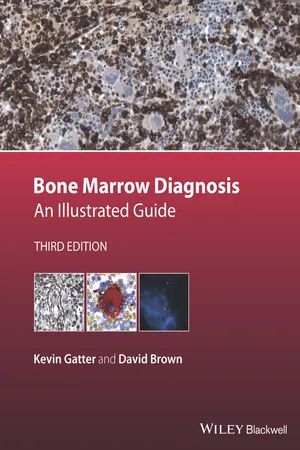
- English
- ePUB (mobile friendly)
- Available on iOS & Android
About This Book
Bone Marrow Diagnosis, Third Edition, is an essential resource for pathologists and haematologists who need to report bone marrow trephine biopsies.
Practical and highly illustrated this edition has been comprehensively updated whilst remaining succinct and concentrating on the core information necessary to make an accurate diagnosis.
The text provides comparisons of the common methods of sample collection, fixation and staining, and a clear description of how to examine a trephine section. Applying a consistent approach, the chapters cover the range of disorders of bone marrow, discussing the clinical features, histopathology of bone marrow and diagnostic problems of each condition. Each chapter closes with a summary of key points and each diagnostic entity is accompanied by high quality images, over 900 in all, showing typical and more unusual examples of histological features.
This compact text, oriented at diagnosis and comprehensively accompanied by usable illustrations, is an invaluable reference tool for the trainee and practicing histopathologists, pathologists and haematologists.
- A practical guide aimed at allowing a busy pathologist to easily find the essential description and illustration of the most common bone marrow diseases seen in trephines
- Covers new treatment for chronic myeloid leukaemia, B-cell lymphoma and antibody treatments
- High quality colour images accompany each diagnostic entity
- Coverage of cytology in sections relating to myeloid dysplasias and acute leukaemias
- Addresses lymphoma categorization and individual lymphoma entities
- Incorporates new WHO classifications of lymphomas and leukaemias
Frequently asked questions
Information
CHAPTER 1
Introduction
| Paraffin embedding | Resin/plastic embedding | |
|---|---|---|
| Advantages |
|
|
| Disadvantages |
|
Table of contents
- Cover
- Table of Contents
- Title page
- Copyright page
- Preface to the Third Edition
- Preface to the First Edition
- CHAPTER 1: Introduction
- CHAPTER 2: The Normal Bone Marrow
- CHAPTER 3: Infections Including Human Immunodeficiency Virus
- CHAPTER 4: Anaemias and Aplasias
- CHAPTER 5: The Myelodysplastic Syndromes
- CHAPTER 6: Myeloproliferative Neoplasms
- CHAPTER 7: Acute Leukaemia
- CHAPTER 8: Lymphomas: an Overview
- CHAPTER 9: Precursor B and T Lymphoblastic Leukaemia (Acute Lymphoblastic Leukaemia) and Lymphoblastic Lymphoma
- CHAPTER 10: Mature B Cell Neoplasms
- CHAPTER 11: Mature T and NK Cell Neoplasms
- CHAPTER 12: Hodgkin Lymphoma
- CHAPTER 13: Metastatic Disease
- CHAPTER 14: Bone, Stroma and Miscellaneous Changes
- CHAPTER 15: Technical Considerations
- Index
- End User License Agreement